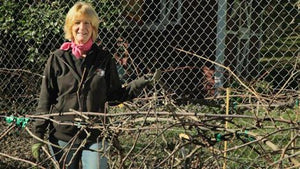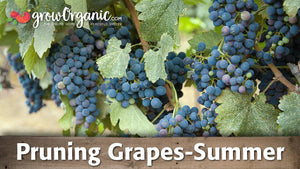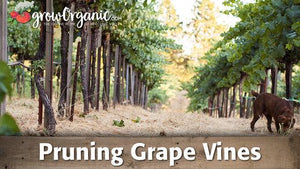Item Number: FV054
Shiraz (Syrah) Wine Grape Vine
Craft Rich, Full-Bodied Wine with the Shiraz (Syrah) Wine Grape Vine
Mix-and-match for free shipping when purchasing 6 or more perennial berries, vines, or crowns!
Bring the richness of world-class wines to your backyard with the Shiraz wine grape—also known globally as Syrah. This iconic grape variety is revered for producing deeply colored, full-bodied wines with bold tannins, vibrant acidity, and the signature notes of black pepper, dark berries, and rich fruit.
Whether you're an aspiring home vintner or an avid gardener, our premium Syrah grape vines for sale make it easy to cultivate the same high-quality grapes used in some of the world's most celebrated wines.
A Grape with Global Prestige
The Syrah or Shiraz grape has roots in the northern Rhône, where it’s the cornerstone of prestigious wines like Côte Rôtie and Côtes du Rhône. Its adaptability to warm climates has made it a global favorite, thriving in renowned wine-producing regions such as:
- Barossa Valley, where Australian Shiraz is known for bold, fruit-forward profiles
- South Africa, producing earthy and spicy expressions of Syrah
- The historic Rhône Valley, delivering structured, age-worthy red wines
When you grow this vine, you're tapping into the legacy of a truly international grape variety that’s central to both French and Australian wine traditions.
Features of the Shiraz Wine Grape Vine
- Flavor Profile: Expect rich layers of blackberry, plum, cherry, and a distinct black pepper finish
- Ideal for Winemaking: Perfect for crafting robust reds or blending with other varietals
- Growth Habit: Vigorous and high-yielding—ideal for home vineyards, trellises, or containers
- Adaptable Climate Performance: Excellent for climates similar to Barossa Valley or South Africa
Growing & Care Information
- Sunlight: Requires full sun (6–8 hours per day)
- USDA Zones: Best suited for zones 5–9
- Soil: Well-drained, slightly acidic soil with organic matter is ideal
- Watering: Maintain even moisture while avoiding waterlogged conditions
- Fertilizer: Use a balanced organic fertilizer throughout the growing season
- Support: Needs trellising or structural support for best yield and airflow
Winter Tip: In cooler climates, protect the roots with mulch or consider container growing for mobility.
Why Choose the Shiraz (Syrah) Grape?
From the spice-driven elegance of Côte Rôtie to the bold intensity of Australian Shiraz, this vine brings a world of flavor home. It’s a top choice for anyone interested in growing wine grapes with a rich history, bold flavor, and exceptional versatility.
Growing your own shiraz wine grape also means direct access to the fresh ingredients needed for crafting wine or enjoying fresh, rich-tasting grapes off the vine.
Order Syrah Grape Vines for Sale
Explore our full collection of grape varieties, including the Shiraz wine grape, at Grow Organic's Grape Vine Collection. Whether you're starting your first vineyard or expanding your existing setup, this vine offers professional-grade performance in your own backyard.
Visit our Berry, Vine & Crowns Characteristics Chart to compare growing characteristics for all our berries, vines, and crowns.



Check Your Zone Compatibility:
Compatible with your zone.
Growing Zone for

Our Guarantee To You
Since 1976, we've served our customers at every stage of growing. Please contact us at any time. We are happy to support and assist you.
Shipping Information
Shipping Information
Cannot ship to the following states: HI , AK , PR , GU , VI , OR , WA , ID
Cannot ship via USPS.
Cannot ship via SmartPost.
Shipping Weight: 3.3 lb
Dimensions: 18.0"L x 3.0"W x 3.0"H
Features
Features
- Open-Pollinated
- Thornless
Characteristics
Characteristics
Planting & Care
Planting & Care
Useful Information
Useful Information
Guarantee
Guarantee
Limited Dormant Tree & Plant Guarantee
* Claim deadline is June 15th
We guarantee that your dormant tree or plant will arrive in good, viable condition. If your tree arrives in substandard condition, notify us within 3 days of delivery. Please email pictures of the box, inside packaging, the tree and its roots to helpdesk@groworganic.com. We will investigate your claim and process a request to exchange or refund the damaged product.
If your dormant tree or plant has not grown new leaves by June 15th, you may be eligible for our Limited Dormant Tree & Plant Guarantee. This guarantee provides for a store credit for the purchase price of the tree, excluding shipping. Please see the Instructions below.
Important Dates:
- April 1st Dormant trees/plants must be planted in the ground
- May 15th Perform scratch test, if no new leaves have grown
- June 15th Deadline to apply for a dormant tree/plant credit
All required documentation must be received by June 15th for your claim to be considered. Claims or documentation received after June 15th will be denied, without exception. Instructions listed below
Terms and Conditions
We cannot guarantee that your tree or plant will remain alive and healthy after it is received, or bear fruit as there are too many variables in your environment that are beyond our control (i.e. soil preparation, weed and pest control, proper irrigation, chill hours, compatible hardiness for your growing zone, proper choice of pollinator, extreme weather, rodent damage, disease, etc.).
We cannot guarantee that we will be able to provide a replacement tree/plant of the same species either that same growing season or in future years. Customers are responsible for all shipping fees associated with replacement trees and plants.
If we determine that the tree you purchased directly from us is not viable, we will issue you a store credit (not a refund) for the purchase price of the affected dormant tree or plant. Shipping is not included in the dormant tree/plant guarantee. Store credits can be used to purchase any product we sell and are valid for use only until July 1st of the following year.
Historically, 98% of our dormant trees and plants grow and thrive when they have been cared for and planted using our growing guides. Dormant trees and plants must be planted in the ground by April 1st in order to be eligible for credit. If the ground in your area is still frozen solid, you may temporarily plant your tree or plant in a pot.
Potted, non-dormant trees or plants are excluded from this guarantee as they are not dormant at the time of shipment. Evergreen trees such as citrus, avocado and olive trees are not available for credit under the Dormant Tree and Plant Guarantee.
Instructions
We guarantee that your dormant fruit tree or plant will leaf out, if you care for it according to our growing guides. In the unlikely event that your dormant tree or plant does not have leaves by May 15th, follow these simple steps to apply for a store credit:
Before you call or email, please perform a “scratch test” to determine if the tree or plant is still alive. This video shows how to check for live tissue under the bark. Scratch tests need to be done a few inches above and below the graft.
Green Cambium Layer / Living Trees
If the cambium layer under the bark is green, give your tree a little more time. It is still alive, but hasn’t come out of dormancy yet. Check to make sure that it is getting the right amount of deep root water, enough sunlight and that the weather is warm enough for that type of tree/plant to come out of dormancy. Every tree has its own personality and will come out of dormancy at different times. Be sure to submit the required documentation listed below by June 15th, if it doesn’t grow leaves.
Brown Cambium Layer / Dead Trees
If the scratch test shows a brown cambium layer or if your dormant tree/plant doesn’t have leaves by June 1st, please email us at helpdesk@groworganic.com. All required documentation listed below must be received by June 15th for your claim to be considered. To be considered for the guarantee claim, all required documentation must be received by June 15th. Incomplete submissions will be denied.
Required Documentation
- Order number
- Name of dormant tree/plant and the quantity affected
- Photos of each tree or plant showing:
- The roots (tree or plant must be pulled out of the ground)
- The scratch test areas
- The entire tree/plant
We reserve the right to not issue credit for items that have already been replaced. We also reserve the right to require photographic evidence that the tree/plant was not killed by root rot, rodent or mechanical damage.
Share


I just ordered a second batch of Shiraz. Much healthier than some I ordered from another place 2 years ago. They are still growing but look stunted.
The roots and stems on these are much more substantial
Most all the Shiraz bare root plants had decent roots. Two plants had smaller stems and limited roots. They may be doubtful survivors. Will not know for sure for several weeks.
Received quickly and well packaged bare root plants. Have been planted and appear to be growing
great picture of the potential product.
Videos
Articles
-
 Sun, Jan 07, 2024
Sun, Jan 07, 2024Planting & Growing Grapes
-
 Wed, Mar 12, 2025
Wed, Mar 12, 2025When to Plant Grapes: A Complete Guide to Planting Grapes in Clay Soil and Beyond
-
 Thu, Jul 03, 2025
Thu, Jul 03, 2025Trim Grapes in Summer With Confidence: Learn How to Trim Grape Vines in Summer and the Secrets to Pruning Grape Vines During Growing Season
-
 Thu, Feb 06, 2025
Thu, Feb 06, 2025Planting & Pruning Grape Vines










